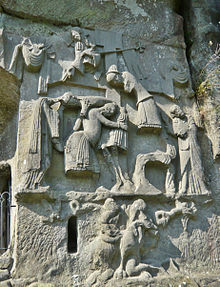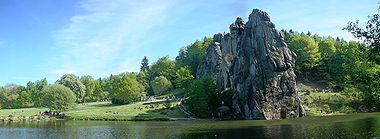- Externsteine
-
The Externsteine [ˈɛkstɐnʃtaɪnə] are a distinctive rock formation located in Ostwestfalen-Lippe of northwestern Germany, not far from the city of Detmold at Horn-Bad Meinberg.[1] The formation is a tor consisting of several tall, narrow columns of rock which rise abruptly from the surrounding wooded hills. The name probably means "stones of the Egge", Egge meaning ridge.[2][3]
Contents
Geology
The Externsteine are a natural outcropping of five sandstone pillars, the tallest of which is 37.5 m (123 ft) high and form a wall of several hundred metres in length, in a region that is otherwise largely devoid of rocks. The pillars have been modified and decorated by humans over the centuries.[1] The geological formation consists of a hard, erosion-resistant sandstone, laid down during the early Cretaceous era about 120 million years ago, near the edge of a large shallow sea that covered large parts of Northern Europe at the time.
History
 The Externsteine relief of the Descent from the Cross. The bent tree below the cross has been suggested to represent the Irminsul, humiliated by the triumph of Christianity.
The Externsteine relief of the Descent from the Cross. The bent tree below the cross has been suggested to represent the Irminsul, humiliated by the triumph of Christianity.
The Externsteine were a centre of religious activity for the Teutonic peoples and their predecessors prior to the arrival of Christianity in northern Europe. Research into this area was carried out as early as 1564 by Hermann Hamelmann.
However, archaeological excavations did not produce any findings earlier than the 11th century BC, other than some Paleolithic and Mesolithic stone tools dating to before about 10,000 BC.[4] As such the precise date when people first used the rocks for rituals has not yet been established.[4]
The last pre-Christian inhabitants of the region were Saxons until their defeat and conversion by Emperor Charlemagne. After conquering Eresburg in 772, Charlemagne is reported to have ordered the destruction of the Saxon Irminsul;[3] (Wilhelm Teudt in the 1920s suggested that the location of the Irminsul had been at the Externsteine).[3] A church dedicated to St Peter was built on the same spot.[3] There is also evidence of an early monastery, which might have been founded as early as 815.[2][3] The findings, however, are not yet conclusive, though the dating of 1093 has been proven false by art historians, who date the relief to early 9th century. One inscription indicates that the Bishop of Paderborn consecrated the grotto in the western columns as a Christian chapel in the early 12th century.[4]
In 1933 Wilhelm Teudt joined the Nazi Party and proposed to turn the Externsteine into a "sacred grove" for the commemoration of the ancestors. Heinrich Himmler was open to the idea, and in 1933 initiated and then presided over the "Externstein Foundation". Interest in the location was furthered by the Nazi Ahnenerbe division within the SS, who studied the stones for their value to Germanic folklore and history.[2]
At the top of the tallest stone is a chamber, now open. Thought to have been once used for sacrifices,[citation needed] little decoration remains apart from one wall with a circular hole cut into it, facing due East. Studies have shown that this may be some form of calendar. On the exact day each year when summer turns to winter, the sun shines exactly onto this hole.
Some Neo-Pagans continue to believe that the Irminsul was located at the Externsteine and identify a bent tree depicted beneath the cross in a 12th century Christian carving with it. The site has also been of interest to various German nationalist movements over the years, and continues to be a popular destination.
Conservation
As early as 1926, the Extersteine was known as ‘one of the oldest and most important nature reserves in Lippe’ and was placed under protection.[5] Today it is approximately 27 acres (0.11 km2; 0.042 sq mi), and forms part of the ‘Teutoburg Forest’ nature reserve, Extersteine [6]
Tourism
In 1958, visitor numbers were around 224,000 people annually.[7] Today, between a half to one million people annually visit the stones, making the Externsteine one the most frequently visited nature reserves in Westphalia.[7]
Some of the Externsteine rocks can easily accessed and climbed. Many of the rock outcrops can be accessed straight from the road. However, in some cases, access is prohibited to protect rare vegetation.
During the day there is an entrance fee for visiting and climbing on the site. However outside the opening hours, some of the rocks are accessible without charge.
Hikers reach the Externsteine from the north, on the Hermannsweg and coming from the south via the Eggeweg, which is part of the E1 European long distance path.
References
- This article incorporates information from the German Wikipedia.
- Bibliography
- Becher, Matthias (2003). Charlemagne. trans. David S. Bachrach. New Haven: Yale University Press. ISBN 0-300-09796-4.
- Runge, Fritz (1 January 1973) (in German). Westfälische Bibliographie. Westfälisch-Niederrheinisches Institut für Zeitungsforschung Stadt- und Landesbibliothek, Dortmund. http://books.google.com/books?id=iIUWAQAAIAAJ. Retrieved 5 March 2010.
- Walther Matthes / Rolf Speckner: Das Relief an den Externsteinen. Ein karolingisches Kunstwerk und sein spiritueller Hintergrund. edition tertium. Ostfildern vor Stuttgart, 1997. (German)
- Hans Schmidt: Externstein-Führer. Hermann Bösmann GmbH Verlag, Detmold 1973.(German)
- Notes
- ^ a b "Externsteine, Germany". sacred-destinations.com. http://www.sacred-destinations.com/germany/externsteine. Retrieved 5 March 2010.
- ^ a b c "Externsteine". greyfalcon.us. http://greyfalcon.us/Externsteine.htm. Retrieved 5 March 2010.
- ^ a b c d e "Extersteine: the quest for Germany’s roots". philipcoppens.com. http://www.philipcoppens.com/irminsul.html. Retrieved 5 March 2010.
- ^ a b c "Mythology: Externsteine". germany-tourism.de. http://www.germany-tourism.de/ENG/culture_and_events/mythology_externsteine.htm. Retrieved 5 March 2010.
- ^ .de/Aufgaben/Organisation/Abteilung5/Dezernat51/Naturschutzgebiete/KreisLippe/Externsteine/index.html bezreg-detmold.nrw.de - "Nature Extersteine"
- ^ reserve LIP-007 "Extersteine"
- ^ a b Fritz Runge: The nature reserves of the former administrative district of Westphalia and Osnabrück. Aschendorff. Munster. 3. Ed 1978th P. 143-144. ISBN 3-402-04382-3
External links
 Media related to Externsteine at Wikimedia Commons
Media related to Externsteine at Wikimedia Commons- Externsteine — Stadt Horn-Bad Meinberg
- Externsteine — Sacred Destinations
- Externstein.de (German)
Categories:- Geography of North Rhine-Westphalia
- Rock formations in Germany
- Nature reserves in North Rhine-Westphalia
Wikimedia Foundation. 2010.



